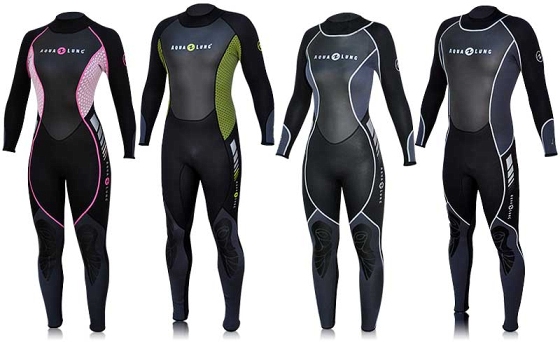is the diver is wet, but warm. The fit of your wetsuit is essential as the more you can minimise the water movement between your body and the outside ocean the less heat will be lost.

WETSUIT CARE AND MAINTENANCE
The following Care and Maintenance information is provided for products that do not have a specific owner's manual and is intended as a general guide for basic care and maintenance of your Scuba Equipment.
MATERIALS:
There are several different types of materials used in wetsuits to achieve specific functions. It is helpful to better understand each of these materials in order to properly care for them.
· Neoprene - Neoprene is the base material that virtually all wetsuits are made of. Neoprene is a type of rubber foam and is typically laminated with other materials depending on the desired function of the material.
· Standard Nylon - A standard nylon outer lining is very durable against normal wear and tear. Normal care must be taken to prevent snagging, abrasion, and cuts.
· Skin material - "skin" material may be used either inside or outside of your wetsuit and often around the wrists, ankles, and neck area. This material has a rubber like appearance either being smooth or textured, and is commonly referred to as "skin-in" or "skin-out". "Skin" neoprene material is typically used in areas where a water tight seal is desired or a benefit can be derived from it's water shedding properties. Some additional care is needed to prevent cutting, or abrasion of this material. Sharp fingernails may cut this material if care is not taken.
· Thermo-skin - This material may be used inside of your wetsuit. Thermo-skin material has a silver-coloured smooth skin type surface. This material has beneficial heat reflective properties and also provides a sealing surface similar to standard "skin" materials. Some additional care is needed to prevent cutting,
or abrasion of this material. Sharp fingernails may cut this material if care is not taken.
· X-Flexor Iso-Flex Neoprene - X-Flex and Iso-Flex neoprene are special materials designed specifically to have a much higher rate of stretch than conventional materials. Due primarily to the looser nit needed to achieve this high degree of stretch; these materials may be more prone to snagging. Velcro may also cause some light snagging and pilling of the material. Some additional care is needed to prevent excessive abrasion or snagging.
Care Before the Dive:
1. With any of the skin surfaces including Thermo-skin, care should be taken when donning the wetsuit to not snag the interior skin surfaces with a fingernail or toenail as this material can be cut. Avoid placing your wetsuit on or near any hot surfaces.
Care During the Dive:
1. The exterior surface of your wetsuit is designed to withstand the normal wear and tear you might encounter during a normal dive. Abrasion against sharp rocks or other sharp objects can cut or puncture the exterior nylon surface so reasonable care should be taken to avoid these situations. Small cuts or tears can be easily
repaired with wetsuit glue. Ask your dive professional for assistance.
Care After the Dive:
1. When removing your wetsuit, first unzip all the zippers completely. Then remove one section at a time taking care to avoid puncturing any of skin surface panels with a fingernail.
Wetsuit Cleaning:
1. Salt water and especially chlorine can "dry out" the neoprene material. When neoprene material "dries out" it loses its flexibility. To ensure the wetsuit material retains its flexibility for a extended period of time, it is important to thoroughly soak and rinse the wetsuit.
2. Soak the wetsuit in a tub of warm fresh water (not over 120°F) for at least 15-20 minutes.
3. After soaking, thoroughly hose off the wetsuit with fresh water.
4. Place the suit on a thick hanger with all the zippers open to ensure maximum air circulation and complete drying.
Wetsuit Storage:
1. Wetsuit material can develop a permanent crease if left folded for a extended period of time. It is best to store your wetsuit laying flat. If that is not possible, you can store your suit on a hanger. Use as thick a hanger as possible to better support the weight of the suit. The thicker the suit, the heavier, and therefore the thicker your hanger should be. There are several after-market hangers available designed specifically for this purpose.
2. Store in a cool, dry and protected place out of direct sunlight.
3. Do not store your wetsuit in garage if the garage is used to park a vehicle. The exhaust emissions from the vehicle can over time deteriorate the neoprene.
Wetsuit Zipper Care and Maintenance:
1. Zippers are designed to be pulled closed or open in a straight line. Try to avoid pulling on the zipper pulls at an excessive angle to their intended path of travel. It is best to ask your dive buddy for zipper assistance in either opening or closing the back-zipper of a one piece back-zipped jumpsuit.
Chemicals/Solvents:
1. Avoid any contact with oil, gasoline, aerosols, or chemical solvents.
2. Do not expose any part to aerosol spray, as some aerosol propellants attack or degrade rubber and plastic materials.
3. Do not use any type of alcohol, solvent or petroleum based substances to clean or lubricate any part.
4. Do not store your equipment near any oil, gasoline, chemicals, or solvents.





